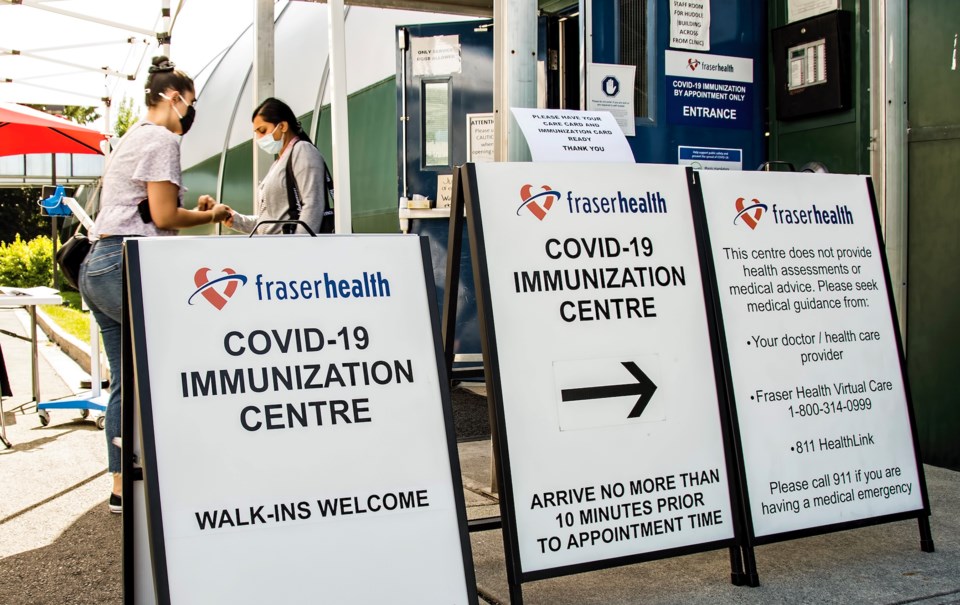B.C.'s pandemic death toll rose by seven on September 15, to 1,873, following intensive care wards (ICUs) consistently hitting months-high numbers of COVID-19 patients.
The seven deaths represent the second-highest COVID-19 death count for a single day since May, after nine such deaths recorded on September 10. Two of the deaths were in the Â鶹´«Ã½Ó³»Coastal Health region, while three of them were in the Interior Health region, and the remaining two were in the Island Health region.
In the past two weeks, there have been 55 COVID-19 deaths in the province.
There is hope, however, that the number of serious infections is levelling off. There are now 137 people in B.C. ICUs, which is three fewer than yesterday, and is the first decline in that number, in a provincial data update, since August 25.
In total, 288 COVID-19 patients are in B.C. hospitals, including those in the ICUs, with that being the same number as yesterday.
While health outcomes are worse for older British Columbians, it has been younger residents who have been responsible for most of the recent infections.
Here is the age breakdown of the 20,740 cases detected in B.C. between August 13 and September 14:
• 90-99: 125;
• 80-89: 290;
• 70-79: 668;
• 60-69: 1,375;
• 50-59: 2,002;
• 40-49: 2,697;
• 30-39: 4,330;
• 20-29: 4,858;
• 10-19: 2,604;
• under 10: 1,789; and
• unknown: two.
In the past 24 hours, health officials detected 661 new infections, raising the number of those infected since the first case was detected in B.C. in late January, 2020, to 176,480.
More than 95.4%, or 168,459 of those, are deemed by the province to have recovered because they have gone 10 days after first feeling symptoms, and are therefore not thought to be infectious.
As a result of new recoveries, the number of those actively battling infections dipped by 374 overnight, to 5,791.
Vaccinations continue at a reduced pace, compared to a few months ago, because the vast majority of British Columbians have already received their needed two doses. A small group of about 15,000 people who are considered extremely immunocompromised are eligible for third doses of vaccine. Invitations for those people to get their third jabs are being sent starting this week.
Health officials provided 13,041 doses of vaccine to British Columbians in the past day, with 6,729 of those being to unvaccinated individuals, and 6,312 going as needed second doses. No data was available for any third doses.
Of the 3,991,888 B.C. residents who have received one dose of vaccine, more than 91.3%, or 3,644,716 are fully vaccinated, with two doses.
The B.C. government estimated in July that the , so Glacier Media's calculation is that more than 77.5% of B.C.'s total population has had at least one dose of vaccine, and 70.8% of the province's total population has had two doses.
Government estimates are that 86.1% of B.C.'s eligible population, older than 12 years, has received one dose of vaccine, while 78.6% of that population is fully vaccinated with two doses.
Vaccinations are important because they hinder new infections, and reduce the seriousness of any infections that do happen.
During the week of September 7 through 13, people not fully vaccinated accounted for 76.5% of new cases. Between August 31 and September 13, not fully vaccinated individuals accounted for 87.3% of hospitalizations, government data show.
This indicates that a small fraction of the population is responsible for the vast majority of new cases and hospitalizations.
The 4,935 cases in the week ended September 13 included:
• 3,375 (68.4%) unvaccinated;
• 400 (8.1%) partially vaccinated; and
• 1,160 (23.5%) fully vaccinated.
Of the 387 hospitalizations in the two weeks ended September 13, there were:
• 316 not vaccinated (81.7%);
• 22 partially vaccinated (5.7%); and
• 49 fully vaccinated (12.7%).
These numbers define unvaccinated as a person who either has not had a jab, or has not gone a full three weeks after a first dose. Partially vaccinated means a person who has had only one jab, or has not gone a full two weeks after the second dose. Fully vaccinated means a person who has gone two or more weeks after receiving a second dose of vaccine.
Another breakdown, for the two weeks that ended on September 13, shows that for every 100,000 unvaccinated people in the province, 321.9 people were admitted to B.C. hospitals. That compares with 100.3 for every 100,000 people who have had one dose of vaccine, and 29.6 for every 100,000 people who have had two doses of vaccine and are considered fully vaccinated.
No new outbreaks at health-care facilities were reported, and no active outbreaks were reported to be over, leaving B.C. with 24 active outbreaks in those seniors' homes and other facilities.
The health regions in B.C. with the highest new cases, and active cases on a per-capita basis are Northern Health and Interior Health.
Glacier Media crunched the numbers for how many of the 661 cases identified in the past day were in each of the province's health regions. The result for the number of new infections for each 10,000 residents (with total new cases in brackets) was:
• 1.3 in Fraser Health (237);
• 0.8 in Â鶹´«Ã½Ó³»Coastal Health (99);
• 2.6 in Interior Health (196);
• 2.1 in Northern Health (62); and
• 0.8 in Island Health (66).
One new case was in someone who normally resides outside B.C.
The result by health region for the 5,791 people fighting active infections for each 10,000 residents (with total new cases in brackets) was:
• 9.7 in Fraser Health (1,744);
• 8.3 in Â鶹´«Ã½Ó³»Coastal Health (1,037);
• 20.7 in Interior Health (1,536);
• 28.3 in Northern Health (849); and
• 7.2 in Island Health (615).
The active case counts include 10 people who normally live outside B.C.



